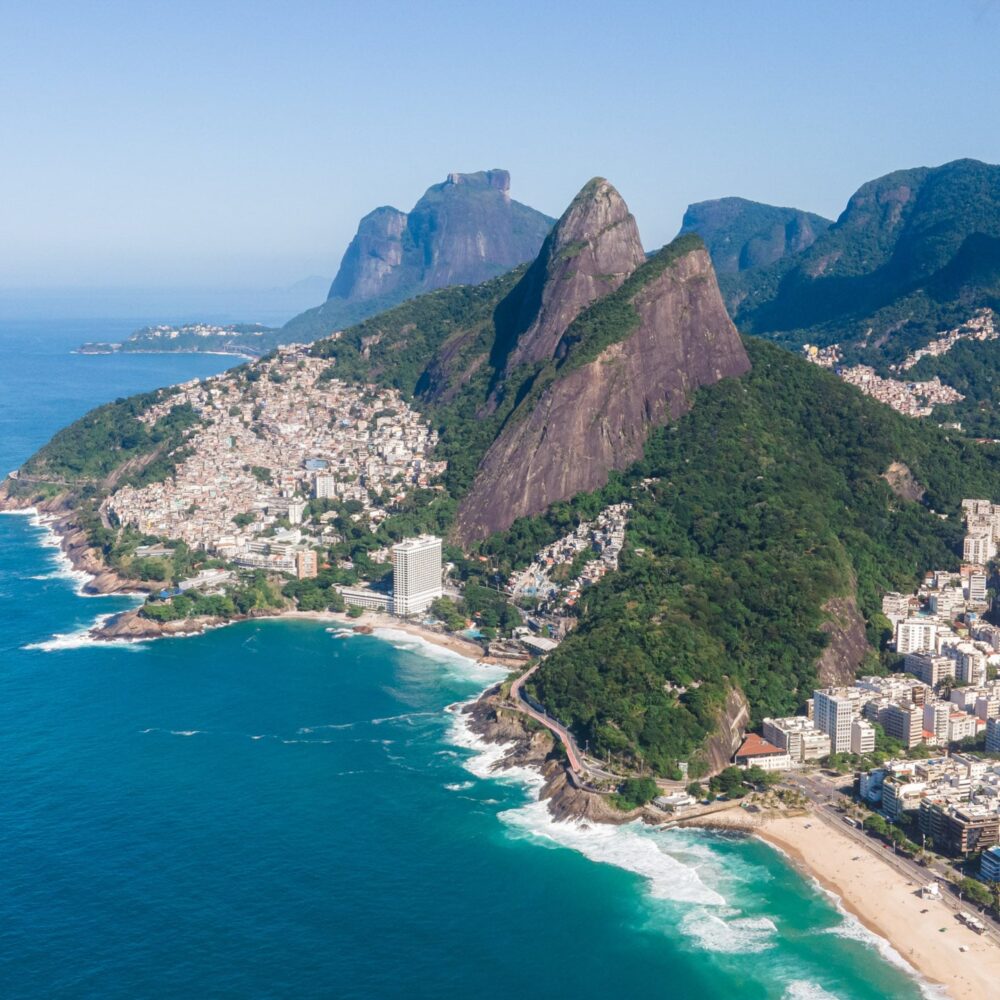The Ultimate Guide To Rio de Janeiro, Brazil
Rio de Janeiro Overview
Golden sands, breath-taking scenery and a rich cultural heritage make Rio an unbeatable good-time destination. Cariocas – as locals are known – know both how to throw a party and make the most of their city’s amazing natural charms. With its vibrant and laid-back lifestyle, street parties and bars fill the air with bossa nova and samba, the beaches are an irresistible draw for sun-lovers, and the hills and waves are alive with hikers, climbers, bikers and surfers. To top it all, the city has a wealth of cultural and historical sites to satisfy one’s intellectual curiosity.
Neighborhood Guide
Although Rio is the second largest city in Brazil, nestled between forest covered mountains and the sparkling bay, it has a strong neighborhood feel. Overall, the city is divided into three main zones – Zona Norte, Centro y Sul. Of these, Zona Sul – the southern zone – with its unbeatable combination of beaches, bohemia and incredible vistas – is what draws most people to the city. Some of the best neighborhoods in Rio, for different reasons, are: Copacabana, Ipanema, Leblon, Santa Teresa, Lapa and Botafogo.
Time to visit
By far the best time to visit is summertime – November to early March, where the temperatures in this jungle like-city vary between low 20s to mid-30s C (F: 70s to 100s) making for perfect beach weather. High season starts in December culminating the week after Carnival (usually late February) and translating into high prices. If you’re hoping to see the city on a budget, early summer (November) is best. Carnival in Rio –the best and most colorful in Brazil – is a destination in its own right. The event attracts visitors from all over the world; beaches are packed, and street parties are everywhere.
If your beach days are behind you, or you’re hoping to see the city’s more cultural sights without the tourist throngs, June and July are still gorgeous with temperatures in the comfortable mid-20s C, although be sure to bring a sweater or three for the cooler nights. Late March and April are known for their abundant annual rains and best avoided.
How to Get There (and Away)
Getting to Rio is easy with daily direct flights to Galeão International Airport from many major Latin, US and European cities or with a quick transfer through the capital São Paolo. The best way to get into town (especially to the Zona Sul where most tourist accommodation is located) is by taxi. Taxi options vary – the cheapest ones are the yellow cabs outside of the terminal. A Radiotaxi from inside the terminal will cost you double, but with a fixed price at around R$130 (US$35) – not a minor detail if you’re caught in traffic. Expect to spend close to an hour (if you’re lucky) or two (if you’re not) to get to Copacabana. If you prefer to Uber there’s a dedicated pick up spot and your ride will be around R$100 for an Uber Black to Ipanema (look for the free airport wifi to connect your phone).
How to Get Around
Getting around Rio is easy – be it by foot, bike, taxi or metro. Don’t try to drive though if you can avoid it; navigating the main tourist areas – especially Ipanema, Copacabana and Santa Theresa – are all walkable.
If you’re looking to take in the city and get some exercise, there are numerous options to rent a bike, and while traffic is somewhat chaotic, the city has the most bike lanes in Latin America. The city bike program (Bike Rio) requires a local cellphone number to release the bikes, but you can also rent directly at bike stands and shops on the east side of Lagoa Rodrigo de Freitas and on the bike path between Copacabana and Ipanema.
Taxis are plentiful in Rio, and can be hailed on the street or from the numerous taxi stands around the city– although apps like 99Taxis or Easy Taxi make planning and paying a little easier if you don’t speak Portuguese. Likewise, Uber or other Radiotaxis you can call from your hotel make this an easy way to get around the city– and highly recommended if you’re venturing out at night.
The metro is safe, convenient, and perhaps the fastest way of getting around the city, and with just three lines to choose from relatively simple to navigate. Its air-conditioned cars also offers a brief respite from the heat! The subway covers most of the sites in Centro and Zona Sul; and a single ride card will set you back just a few reais, or charge a cartão pré-pago (prepaid card) in any metro station with a R$5 minimum. The metro now integrates with the city’s bus system to literally make your reais go further. It runs from 5am to midnight Monday to Saturday with slightly reduced hours Sunday and holidays. When partying really gets underway in the city on New Year’s and Carnival, however, trains run all night.
Essential Details:
- Language: The official language of Brazil is Portuguese
- Money: The Brazilian currency is the Real (R$, reais (pl)). You’ll need to have some on hand for short cab rides, the bus, or picking up a coconut water to quench your thirst on a hot day. ATMs are widely available, although opt for ones housed inside banks. Banco do Brasil is one of the country’s largest banks with a large network of branches around the city. Credit cards are widely accepted – particularly Visa and Mastercard – and likely your best option when paying for dinner or your hotel.
- Entry requirements: Generally, you don’t need a visa to enter Brazil as a tourist. With a valid passport, it should have a minimum validity of 6 months after arrival. Check with your embassy on Covid health regulations to see if you can travel to Brazil
- Electricity: In Brazil, two plug types are used – Type C (two round pins) and type N (two round pins and a grounding pin). Voltage is 220V
- Cell Service: Prepaid Sim cards are cheap (around R$10-15) and widely available from mobile phone stores. While you can buy them from a host of other places (e.g. supermarkets, pharmacies, etc), online set up (in Portuguese!) will ask you for a local ID number with no easy work around. Getting it set up at an operator is usually the simplest option
Where to Stay
Where to Stay
The most famous beach neighborhoods in Rio are, without doubt, Copacabana and Ipanema. Known globally for their spectacular urban sands, these neighborhoods have drawn people from around the world for decades. These fashionable beach areas offer a wide variety of hotels, restaurants, and shopping. Copacabana: Look out for the distinctive black and white mosaic waves on the promenade – which have become Rio’s unofficial logo. More upscale (read: expensive), Ipanema is the less crowded of the two, with closer access to the Lagoa (laguna) and the gorgeous botanical gardens. Bordering Ipanema is Leblon, one of the most exclusive areas of Rio, with its own golden (and less busy) beaches, excellent shopping, and swanky restaurants. More residential, this area is home to some of the city’s wealthiest.
The best neighborhoods to experience Brazil’s rich and hip cultural vibe are Santa Teresa, Lapa and Botafogo.
- Santa Teresa is a picturesque, bohemian, and maybe tad dilapidated, location filled with colonial villas and romantic restaurants. This hill-top district is home to a strong Brazilian art-scene – both new and old, from artists’ studios and galleries to the Chacara do Céu Museum. The latter is known for a daring daytime heist of the Museum’s prized impressionist paintings in 2006. The Dali, Picasso, Matisse and Monet remain missing and the theft listed as one of the FBI’s top ten art crimes.
Set back from the beach, Botafogo has long had a reputation of an “in-betweener” neighborhood, only seen on the way to and from the city’s main draws. However, in recent years, thanks to its affordable rents, a creative, entrepreneurial and hipster crowd has moved in. This has sparked a movement in slow food, quirky bars and craft beer, and the neighborhood has become a great place to check out up-and-coming chefs.
What to Eat
Rio’s food scene has developed as a perfect complement to the city’s laid-back lifestyle. Start the day (or any social visit!) with a cafezinho (little espresso), topped off with pão de queijo (cheese bread) or a healthier alternative of an açai bowl or smoothie. Originating from the Amazon, the acai berry was popular in Rio long before it earned its global superfood status. Enjoy a beach side snack of fried sardines with a pinch of salt and a dash of lime, washed down with a coconut water from a street vendor (read: machete opened coconut with a straw!) For a local taste for lunch head to a ‘por kilo’ restaurant – where food is paid by the weight consumed and the menus abound with traditional fare. There is nothing better for a decadent afternoon pick me up than Brazil’s most famous dessert, the brigadeiro – a combination of condensed milk, butter, and cocoa rolled into balls and covered with chocolate sprinkles. Finish the day off with a (not so cheap) dinner at a churrascaria rodizo – a grilled meat extravaganza, where waiters continue to bring meat racks to the table until you beg them to stop.
Of course, last but not at all least, is the infamous Caipirinha, a blend of lime, sugar, cachaça and ice. Bartenders across Rio compete for the title of the city’s best – mixing up the original with exotic flavors from watermelon and passionfruit to strawberries and chile. Be warned, they go down far too easily!
Sights of Rio de Janeiro, Brazil
Rio is a laid back, beach-going party town, making it the perfect place to visit for any interest.
Most Popular Things to do in Rio de Janeiro
Christ the Redeemer: As Brazilian as football, this towering cultural icon has become a symbol of Rio. The art deco statue was erected in 1931 and, at a towering 38 meters, is considered to be one of the new Seven Wonders of the World. No visit to Rio is complete without making your way up Mt. Corocovado peak to marvel both at this iconic work of art and the incredible view of Rio’s Zona Sul it offers. Take note, this site attracts a crowd, so be sure to visit early (before 10 AM). The best route up is on the tram ride from Cosme Velho (buy your tickets from a RioTur office), but there are plenty of other official and unofficial vans and taxis to get to the top (the last segment is official transport only). If you’re up early and feeling more adventurous, head over to Parque Lage and follow the hiking trail all the way up. Stop off at Parque Lage either way; at the foot of Corcovado, the palace is now an art school and exhibition center with a hidden aquarium (Tip for music fans: the mansion was used in Snoop Dogg and Pharrel Williams’ ‘Beautiful’ video!)
Sugarloaf Mountain: This site is quintessential Rio, and one of the city’s top locations for watching the sun go down thanks to its jaw-dropping views of Rio and its beaches. This distinct 396m granite-quartz peak rises steeply from Praia Vermelha at the mouth of Guanabara Bay and the area boasts over 270 rock routes making it a prime destination for urban rock climbers. But don’t worry, if climbing is not your idea of fun, the Sugarloaf Cable Car, which has been running since it was installed in 1912, gets you up there with a whole lot less effort! The cable cars run every 30 minutes with a stop at Morro da Urca, before heading up to the summit. Arrive early afternoon to enjoy the dramatic Vermelha beach before heading to the cable car about two hours before sunset to make the most of your visit.
Hit the beach – or all of them! Rio’s world-renowned golden beaches offer something for everyone, whether you’re looking to work on your tan, a little people-watching or volleyball, or take to the waves. While each beach is distinctive (Copacabana and Ipanema draw a large crowd, Leblon is quieter, and Arpoador is considered a surfer’s paradise and a key spot to watch the sun go down), look out for the life-guard towers (postos) which serve as something of a zoning guide for each beach. Posto 6 (Copacabana) is good for swimming and paddle-boarding, Posto 8 (Ipanema) is family-friendly with pools forming at low tide, Postos 8-9 is a well-known LGBTQ attraction, while Posto 9 is a favorite for seeing and being seen. Most beaches offer rental chairs, beach umbrellas, cafes and free showers. A seemingly endless stream of vendors trek the beaches with drinks, snacks, and beach toys.
Jardim Botanico (Botanical Gardens): Founded more than 100 years ago, these huge (think 137 ha) gardens have thousands of plant species including impressive and rare collections of orchids and bromeliads. Its combination of elegant landscaped areas and imperial palm-lined walkways with tropical lush jungle areas makes for a unique and serene experience. Capuchin monkeys, sloths, tortoises, hummingbirds and toucans provide entertainment. This is a great place to start the day with brunch at the local café or keep the garden exploring going by walking along Rua Jardim Botancio to the nearby Parque Lage for a leisurely outdoor lunch in its stunning colonial mansion.
Bike around the Lagoa (lake): Considered one of the best parks in the city, and located next to Ipanena and Leblon, the Lagao offers an excellent place for biking and immersing yourself in nature – just a few blocks from your Ipanema beach side hotel. Finish off your afternoon out with a caipirinha to watch the sunset.
Dance the night away in Lapa: Over the past few years, Lapa has shaken off its dive bar reputation to become the vibrant center of Rio’s nightlife and music scene. Hip hangouts and nightclubs abound alongside favorite music venues in century old mansions. Rub shoulders and sip caipirinhas with locals and tourists alike, dancing to everything from traditional samba vibes to funk and electronics spun by international DJs. Music lovers should be sure to check out Circo Voador, a palm-lined destination for both foreign and local bands alike. If you’re looking for something even more authentic, head to Pedra do Sal. Known as ‘Little Africa’ for its strong Afro-Brazilian heritage, today, the birthplace of samba draws in music lovers to street parties with cheap caipirinhas, delicious food and colorful murals.
Museum of Tomorrow: While many of Rio’s attractions are based on its picturesque settings of golden beaches and tropical forests or its rich historical and cultural legacies, the Museum of Tomorrow offers up something quite different. The futuristic museum built in the run-up to the 2016 Olympics focuses on mankind’s future. Sustainability is a central theme from the exhibits to the building’s own design – look for the solar panels and water cooling systems. With interactive exhibits, this is a great way to spend a few hours for visitors of all ages. Check out the food trucks on the neighboring Olympic Boulevard for lunch.
Off the Beaten Path: Feira Libre da Glória (Gloria Farmer’s Market): Tables buckling under the weight of fresh fish and exotic tropical fruits (guavas, starfruit and papaya are just the start), this is not your average farmer’s market. The Sunday morning market is a great place for serious foodies to immerse themselves in the city’s authentic food culture (and ease out of a Saturday night hangover) before heading back to the beach for the afternoon.
Day Trips From Rio de Janeiro, Brazil
With its wealth of beaches and cultural attractions, it is hard to run out of things to do in Rio. Nonetheless, if you’re interested in exploring further afield, there are several day trips from Rio that are well-worth the time!
- Day Trip from Rio to Angra Dos Reis and Ilha Grande: The 3-hour 168km bus ride south of Rio to Angra dos Reis is something of a time commitment, but it is worth it. The port town, whose name translates to Bay of Kings, offers plenty of options for exploring – from markets, churches, and buildings, to over-land treks with towering waterfalls and isolated beaches. While a destination in its own right, Angra Dos Reis is perhaps best known, however, as a kickoff point to explore its nearby archipelago of 365 islands – the crown jewel of which is Ilha Grande. A top destination for day trippers from Rio. Just a 30-minute boat ride from the port, Ilha Grande is an abundance of riches with lush Atlantic forests, exotic wildlife and sandy beaches; the best of which is palm-lined Lopes Mendes which has been listed as one of the most beautiful beaches in the world and is a favorite amongst surfers. With a chequered history – think a penal colony for Brazil’s most dangerous criminals, Ilha Grande is now a car-free protected area with endangered species such as the brown howler monkey and mane sloths populating its forests. With hiking, surfing, snorkeling and diving (visit Lagao Azul for the latter, complete with sting rays and turtles), the island is so perfect for adventurers that you will even have a hard time heading back to Rio!
- Day Trip from Rio to Paraty: To feed your inner artist, head south of Rio to Paraty. Set against the stunning backdrop of the Bocaino Mountains, car-free Paraty is a small colonial town with whitewashed buildings and cobblestone streets that has remained virtually intact since the 18th century. In times gone by, the town was a gateway to the gold mines of Minas Gerais (visitors today can explore along the old gold trail), today it is better known as a cultural outpost. The town is a major attraction for artists and writers, not least for its spectacular scenery, but also for its annual cultural festivals. The most well-known of these is FLIP (the International Literary Festival of Paraty), which launched in 2003 and helped put the town on the map. Self-styled after the renowned British Hay Festival, FLIP brings in international authors and greats from the world of culture. Held in annually in July (although check if it’s a World Cup year – as with all things in Brazil, football takes precedence!), this provides an excellent day trip from Rio when the weather is not great. Enjoy a leisurely lunch at one of the many restaurants that flow out into the narrow streets. Of course, if exploring Brazil’s beaches or natural wonders is more your style, Paraty offers plenty. Take a boat trip around the bay or set off on a hike to explore some of the town’s best natural spots – waterfalls included.
- Day Trip from Rio to Buzios: This one-time sleepy fishing village north of Rio is now a popular destination amongst water-lovers – from kite-surfers to SUP, kayakers, divers and snorkelers. Built on a peninsula jutting into the Atlantic, the conditions on the Eastern and Western beaches differ, making it a mecca for all with over 20 beaches to choose from (Geribas is considered a surfer’s paradise for its large waves!) It was French Brigitte Bardot who made the town world famous in the 1960s, but today, the city is just as popular with cariocas. Weekends and holidays see the who’s who of Rio heading to enjoy Buzios’ laid-back beach life and trendy nightclubs (be sure to make reservations in advance!) Try a weekday visit for a less crowded alternative. A bus from Rio’s bus terminal will take less than three hours, but there are numerous companies that offer day trips to the peninsula.
- Day Trip from Rio to Petropolis: If you need a break from the sun and the beaches (sunburn got the best of you?), this mountain resort (the former Imperial City of Brazil) in Serra dos Orgaos valley makes for a perfect day trip from Rio. Just an hour and a half bus ride (cerca 68 km) from the city, this mountain location has long been a favorite summer getaway for cariocas, from the Brazilian Emperors of the 19th century to Rio’s current jet set. With cooler temperatures offering a respite from the sizzling city, visitors can enjoy city walks or hiking some adventurous mountain trails. Must see spots in this cultural hub include the Imperial Museum (the former summer palace of King Pedro II), the gothic Cathedral São Pedro de Alcantara, the Centro Histórico and the Crystal Palace – which is built entirely out of glass.
- Day Trip From Rio to to Parque Nacional Serra dos Órgãos: Hikers and climbers should head to Parque Nacional Serra dos Órgãos (Serra dos Órgãos National Park), which boasts ten +2,000m peaks, including the better known Dedo de Deus (God’s Finger). Rock climbing and hiking abound – including a 1.3km path suspended some 9 meters above the floor. For those with more time on their hands, a three-day 30km trek connects Teresópolis and Petropolis complete with tends for hire.

















































